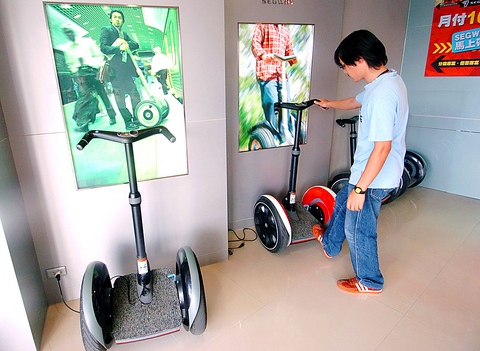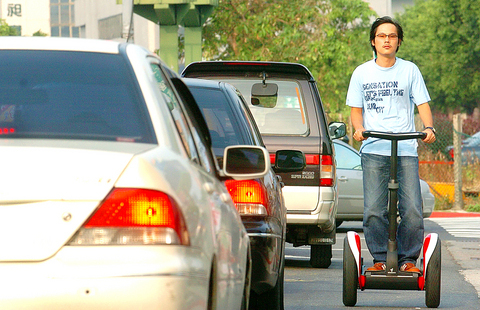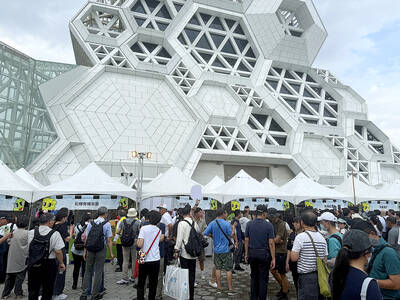It was code-named "Ginger" and was going to be nothing short of a revolution. And for many months, speculation was rife on the Internet as to just what the revolution was going to be about. Was it a communications device? Was it another medical innovation?
Its inventor, Dean Kamen, became famous -- and grew rich -- for having developed various medical technologies, including the world's first portable dialysis machine. He'd most recently invented a US$25,000 wheel chair, the IBOT, that goes over curbs, climbs stairs, and lifts its user to eye-level with the rest of the world.
Given the nature of his last invention, those who knew Kamen best supposed it was likely a transportation device.

PHOTO: CHANG CHIA-MING, TAIPEI TIMES:
What it turned out to be was Segway HT, short for "human transporter." And while it hasn't proven to be quite the revolution that was promised, the technology behind the invention has some promising applications.
And now Segway has come to Taiwan. The company opened a sales center in Neihu (內湖) in August and has turned motorists' heads on Minchuan East Road since then.
The first question most people ask: What keeps you from falling down?

PHOTO: CHANG CHIA-MING, TAIPEI TIMES
The answer: At first, it's the sales rep holding the machine for you. My first step onto Segway nearly sent me to the floor. The question was which way, onto my back or on top of Segway sales representative Laura Jian (簡竹均符), who was standing in front of me, trying to steady both the machine and my nerves. I'd broken the first and only rule of riding a Segway by allowing my feet to rock back and forth. Doing so causes the machine to overcompensate by accelerating front and back in rapid succession.
"Keep your feet steady and your body straight," Jian said. "Let the Segway balance you instead of trying to balance yourself on the machine."
She was right. The minute you trust the machine to balance you is the moment you gain control. A moment later I was zipping around the showroom, albeit less gracefully than Jian had in her demonstration. She was able to dance a little jig on the machine while I looked more like Wile E. Coyote on an ACME rental. Still, heads on Minchuan East Road were turning.
Though it's true that Segway is an intuitive ride, the absence of brakes is a bit unsettling at first. Lean forward to go forward, lean back to go back. Turn by twisting the left handle grip. All that was easy. Stopping was a different matter. Riding anything else, stopping is something you do with your foot or hand and as I rolled toward the showroom's glass front wall, I found myself wanting to reach for something that wasn't there.
Trusting the machine to stop by just standing straight again, that part was more difficult. By far the greatest thrill of my test drive, though, was standing on the Segway after bringing it to a complete stop and not having to consciously balance myself.
At the heart of the machine are five gyroscopes and two tilt sensors that work in tandem with speedy computers and high-torque motors -- one for each wheel. The computers check your center of gravity 100 times per second and automatically respond to changes in your body potion. "Dynamic
stabilization," they call it. There's no learning how to ride the Segway beyond having a quick demonstration. Unlike having to learn to ride a bicycle, the Segway already knows how to carry you. Just stand straight.
To charge it, plug it into any standard outlet. Another of Segway's technology breakthroughs is its integrated charge-management electronics, a circuit board attached to each of two lithium-ion batteries that constantly monitor temperature and voltage to help maintain the optimum charge rate.
On a full charge, Segway can go up to 38km, though the product's literature is quick to point out that actual distances vary depending on terrain and other factors. One model Segway's four models, the GT, is made for hauling a golfer and his or her clubs, and is designed to play 36 holes on a full charge. Another model, the XT, for "cross-terrain" is distinguished by oversized tires and a higher ground clearance. The tow models made for cityslickers, the "i" and "p" series, are the original Segways. The former is slightly larger and can handle a wider variety of terrain. The latter is more portable and made only for paved surfaces.
The company claims that the Segway HT will "change the way you think about travel." Indeed, it makes you wonder whatever became of walking. And some of the "solutions" it offers leave you wondering what the problem was. Law enforcement officers in the US who have used Segways profess to be able to patrol more of their beat and more quickly than they could on foot. Of course, a bicycle allows for the same, but can go further and faster, and at a fraction of the cost to taxpayers as a Segway.
The price of the Segway IE70, the only model currently available in Taiwan, is NT$240,000. A local sales representative with Segway claims the company has sold over 400 units since opening shop. There is also a local Segway club for owners and non-owning enthusiasts to gather and play and with the machines. Check out www.segwaytw.com.tw for details.
The revolution would be complete if only the company could drop a zero from the price of Kamen's invention. No amount of "dynamic stabilization" will keep you from falling over once you've seen the Segway's sticker. "Redundant systems" may help keep you upright, but you need redundant cash to first step onto it.
Indeed, the company says that Segway has come to Taiwan and other parts of Asia largely because of lackluster sales in the US, where regulations in many cities prevent the machines from sharing the sidewalk with pedestrians.

It’s Aug. 8, Father’s Day in Taiwan. I asked a Chinese chatbot a simple question: “How is Father’s Day celebrated in Taiwan and China?” The answer was as ideological as it was unexpected. The AI said Taiwan is “a region” (地區) and “a province of China” (中國的省份). It then adopted the collective pronoun “we” to praise the holiday in the voice of the “Chinese government,” saying Father’s Day aligns with “core socialist values” of the “Chinese nation.” The chatbot was DeepSeek, the fastest growing app ever to reach 100 million users (in seven days!) and one of the world’s most advanced and

Has the Taiwan People’s Party (TPP) changed under the leadership of Huang Kuo-chang (黃國昌)? In tone and messaging, it obviously has, but this is largely driven by events over the past year. How much is surface noise, and how much is substance? How differently party founder Ko Wen-je (柯文哲) would have handled these events is impossible to determine because the biggest event was Ko’s own arrest on multiple corruption charges and being jailed incommunicado. To understand the similarities and differences that may be evolving in the Huang era, we must first understand Ko’s TPP. ELECTORAL STRATEGY The party’s strategy under Ko was

The latest edition of the Japan-Taiwan Fruit Festival took place in Kaohsiung on July 26 and 27. During the weekend, the dockside in front of the iconic Music Center was full of food stalls, and a stage welcomed performers. After the French-themed festival earlier in the summer, this is another example of Kaohsiung’s efforts to make the city more international. The event was originally initiated by the Japan-Taiwan Exchange Association in 2022. The goal was “to commemorate [the association’s] 50th anniversary and further strengthen the longstanding friendship between Japan and Taiwan,” says Kaohsiung Director-General of International Affairs Chang Yen-ching (張硯卿). “The first two editions

It was Christmas Eve 2024 and 19-year-old Chloe Cheung was lying in bed at home in Leeds when she found out the Chinese authorities had put a bounty on her head. As she scrolled through Instagram looking at festive songs, a stream of messages from old school friends started coming into her phone. Look at the news, they told her. Media outlets across east Asia were reporting that Cheung, who had just finished her A-levels, had been declared a threat to national security by officials in Hong Kong. There was an offer of HK$1m (NT$3.81 million) to anyone who could assist